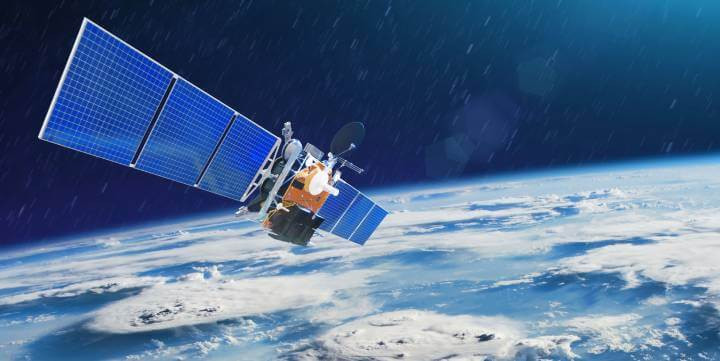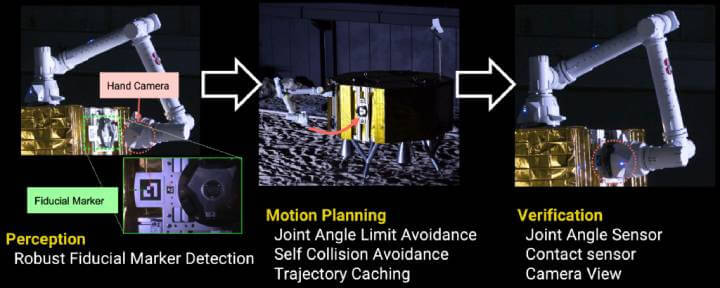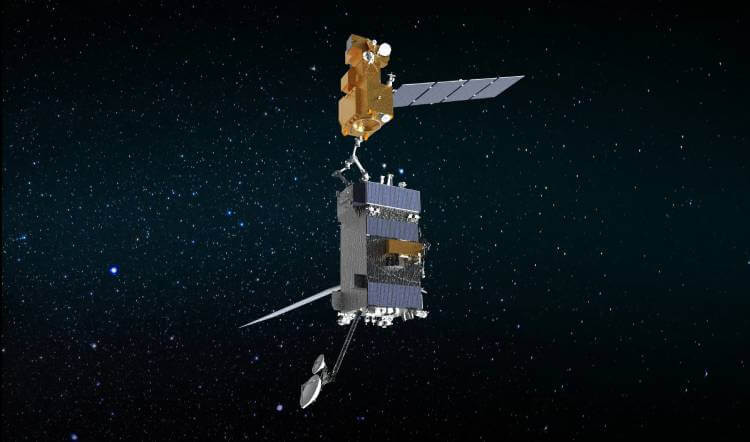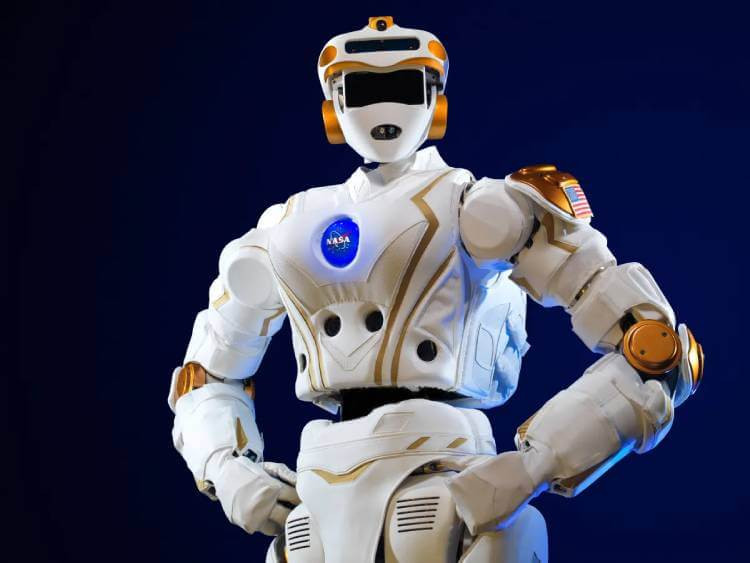AI and Robotics to Play Key Roles in Space Exploration
Insights | 19-02-2024 | By Gary Elinoff

Essential Insights into Space-based AI and Robotics:
- Robotics and AI will play key roles in space-based construction, deployment and maintenance.
- Radiation and zero gravity are deadly hazards for humans in space.
- Robots can do much of the work where radiation is present, such as extra-vehicular activity, saving human astronauts from excessive exposure.
- The Gitai Inchworm Robot showcases the practical application of robotics in mitigating hazards for humans in space, particularly in performing tasks in areas with high radiation exposure, demonstrating the critical role of autonomous systems in ensuring astronaut safety.
- As of now, there isn’t much that can be done to protect astronauts from the deleterious effects of zero gravity.
Introduction
It’s been estimated that there are close to 10,000 satellites in orbit around the Earth today, a number that is nuanced due to the secrecy surrounding many military and corporate satellites. As far back as 2021, SpaceX's Falcon 9 rocket made headlines by launching a record 143 satellites into orbit in a single mission. Thanks to the reusable nature of the Falcon 9, the cost per satellite launch has significantly decreased, setting the stage for an exponential increase in the number of satellites orbiting our planet. Amidst this burgeoning activity in space, the indispensable role of robotics, exemplified by the maintenance work on celestial observatories like the Hubble Telescope, becomes ever more critical. These mechanical custodians are pivotal in ensuring that our windows to the cosmos remain unobscured, allowing us to witness the majestic dance of star formation and the evolution of the universe. Learn more about Hubble's discoveries[1].
As of early 2024, most of these space vehicles are launched into eccentric low earth orbits (LEO). They are, in a sense, similar to internet servers in that they are interlinked; if one fails or is destroyed by an enemy, other members of the “swarm” will pick up the slack. Because these “birds” (an industry term for a satellite) are relatively inexpensive and they can be launched by the score, the loss can be easily absorbed. While visionaries are targeting the Moon and Mars, most of the meat and potato space work, such as military reconnaissance, communications and scientific research, is done by cheap, easy-to-launch LEO birds.
But now, some space-based applications require GEO, or geosynchronous satellites, which tend to be much more expensive, and launching them to their very high and very specific orbits is quite expensive. Unlike the LEO satellites, GEO birds can cost hundreds of millions of dollars and, as such, are not readily disposable.
Advancing Spacecraft Technology for Lunar Exploration
As we prepare our spacecraft for lunar voyages, such as the Artemis II mission, the meticulous application of iconic insignias symbolizes the precision and care robotics bring to our space endeavors. These robotic artisans, with their exacting standards, lay the groundwork for humanity's lunar aspirations. Discover more about Artemis II [2].
Addressing the high costs and risks associated with GEO satellites, missions like NASA's OSAM-1[3] introduce innovative solutions for on-orbit servicing. This not only extends the operational life of these valuable assets but also demonstrates a shift towards more sustainable and cost-effective space operations.
Further into the future, it is expected that massive, vastly expensive solar power stations will be placed into space to microwave virtually unlimited solar power down to Earth. It is also hoped that much of agriculture and manufacturing can also be transferred off the planet, eliminating the generation of vast amounts of pollution of every sort.
Harnessing Space for Sustainable Earth and Lunar Exploration
NASA's recent experiments shedding light on moon dust's charged properties reveal the intricate challenges awaiting us on the lunar surface. This research underscores the complexity of the lunar environment and the critical role robotics will play in navigating and utilizing this terrain for future missions. Explore NASA's findings on moon dust[4].
So, it is evident that there is now a need for space-based “field service” for devices like GEO satellites and, later, for large-scale infrastructure. But, as we shall see, human beings won’t be able to safely handle it alone.
Reflecting on the meticulous preparation for Mars, NASA's call for participants in a simulated Mars mission[5] underscores the blend of human ingenuity and robotic precision essential for the Red Planet's exploration. This initiative mirrors the symbiotic relationship between astronauts and their robotic counterparts, setting the stage for groundbreaking discoveries on Mars.
Radiation and Gravity
Radiation and gravity, or rather the lack of gravity, are hazardous to humans. The danger that radiation presents to human beings needs no explanation. On Earth, harmful radiation from space is largely blocked by the atmosphere; in space, that protection is missing. And, while short-term exposure to zero gravity can be tolerated, the long-term hazards from zero gravity that our hypothetical repair and construction people would have to endure include bone loss and other physiological damage.
The whispers of deep space signals, as unveiled by NASA's telescopes, beckon us with the promise of unravelling the universe's mysteries. This pursuit of cosmic knowledge is bolstered by the seamless integration of human curiosity and robotic efficiency, broadening our understanding of the cosmos. Read about deep space signals [6].
In the future, it can be anticipated that flexible, thin-film space suits will be developed to block radiation.
The zero gravity problem may also be eventually overcome through the use of a method reminiscent of the popular Gravitron carnival ride. A wheel spinning on its axis will create centrifugal force emanating outward from the axis.

Simulating gravity: Munich, Germany - October 2: Renowned Chain Carousel and decorations at the Oktoberfest in Munich on October 2, 2023.
When the wheel on top of the ride spins, the participants are forced outwards, being restrained by the cords they are attached to. If the riders were located inside the wheel, they would, in effect, experience “gravity”. For astronautic repair people who remain in space for long periods of time, residing on the inside of the wheel will provide faux gravity proportional to the wheel’s radius and rotational speed. Practical difficulties preclude this method, at least for now.
So, the challenges presented by zero gravity and radiation remain deadly hazards to long-term residents in space, such as our hypothetical repair and construction people. And it will be space-based robots that will serve to ameliorate these difficulties.
Robotic solutions like the Inchworm Robot are pivotal in overcoming the challenges posed by zero gravity and radiation. Their ability to autonomously navigate and perform intricate tasks on spacecraft surfaces without human intervention showcases the critical role robotics will play in future space missions.
Gitai’s Inchworm Robot
Gitai states on its website that its ambitious vision is “To provide a safe and affordable means of labour in Space” and to be a part of “providing safe and affordable labour to build space colonies and cities on the Moon and Mars.”
As described by Gitai[7], the company’s Inchworm Robot is designed specifically for use in space stations and satellites, purposed as a powerful and reliable solution for maintenance, repairs, and scientific experiments in space. Each individual robot can extend up to two meters in length and offers 7 degrees of freedom, providing significant reach and flexibility. This is illustrated by the capability to link two of the devices together. Equipped with its own sensors and animated by AI, the Inchworm Robot represents a pragmatic approach to building a moon base, according to the company.

Anticipating the ultraviolet wonders and stellar cataclysms, NASA's forthcoming mission to study the ultraviolet universe is poised to peel back the celestial curtains. In this endeavor, robotics and AI are our trusted guides, steering us through the cosmic unknown with precision and insight. Among these technological marvels, the well-named Inchworm Robot exemplifies innovation by inching and worming its way along satellites, adeptly handling tools to accomplish tasks before moving to the next location. This astonishing display of technology in action underscores the pivotal role of robotics in space exploration. Learn about the ultraviolet mission[7].
Gitai’s Inchworm Robot.
Off-World Refueling and Construction
On-orbit Servicing, Assembly, and Manufacturing 1 (OSAM-1) is a robotic spacecraft funded by NASA. In an article published by NASA[2], this innovative spacecraft is described as being purposed to service and extend the life of satellites, even those not originally designed to be serviced.

Artist’s concept of OSAM-1 (bottom of the picture) docking with a satellite (top). Image source: NASA
An OSAM-1 mission is planned to be the first to robotically refuel a spacecraft not designed for on-orbit servicing. The servicer will rendezvous with, grapple, and berth the government-owned Landsat 7 spacecraft and then use a suite of tools to replenish its hydrazine fuel tank.
Additionally, NASA, in cooperation with its commercial partner MAXAR, has planned a demonstration involving the OSAM-1, which is equipped with Maxar’s Space Infrastructure Dexterous Robot (SPIDER). Here, a robotic arm will be employed to assemble, from parts, a Ka-band antenna as a functioning part of a spacecraft in space orbit.
Humanoid Robots to Handle Dangerous Tasks in Space
As described in an article published in Reuters[8], NASA and its industrial partners are developing human-like robots to handle not only dangerous tasks but also boring tasks, freeing up their human masters for their real tasks, such as exploration and discovery.

NASA’s Valkyrie robot Image source: NASA
NASA is partnering with companies like Apptronik to explore the concept of human-like robots such as Valkyrie for space-based applications. Apptronik is also busy developing anthropomorphic robots, such as its Apollo, for more terrestrial applications.
But why go to the trouble of mimicking the human form? Because a humanoid robot, with a torso, head, two arms and two legs will be most capable of using the same equipment, the same tools and will fit into the same spaces that a human would be able to.
As described by NASA Dexterous Robotics Team Leader Shaun Azimi, humanoid robots in space could potentially handle risky tasks like cleaning solar panels or inspecting malfunctioning equipment outside the spacecraft. And, as pointed out by Apptronik Chief Technology Officer Nick Paine, Apollo possesses clear advantages over its human counterparts, particularly endurance. He states, "We're targeting having this system online 22 hours a day." That’s even more than the toughest human astronaut can handle.
The development of humanoid robots, such as those being explored by NASA and its partners, represents a significant advancement in space robotics. These robots are designed not only for endurance but also for versatility, capable of performing a wide range of tasks that would be impractical or too dangerous for human astronauts.
Challenges and Opportunities
As it stands in early 2024, most of the “action” in space revolves around relatively cheap, easy-to-replace LEO satellites. These devices often operate in swarms, and if one goes down, its cohort devices can shoulder the load until the next batch is blasted into orbit.
But that’s not always the case. GEO satellites, operating further out in space, are quite expensive, and if one runs into operational difficulty or needs a fuel “fill up”, a human astronaut is unlikely to be available, and even if one was, it would be dangerous for that person to be exposed to the radiation that is part and parcel of space.
The problem will be even more acute later on when the complex structures that will be part of the future space-based economy begin to emerge. And, even when the hazards of zero gravity and radiation can be effectively combated, why send in a human when a robot can do the job?
The strategic deployment of robotics in space, exemplified by projects like the Inchworm Robot and OSAM-1, underscores a broader trend towards automation and remote operation in space exploration. This approach not only mitigates the risks to human life but also enhances the efficiency and scope of space missions, paving the way for more ambitious projects like space colonization and deep-space exploration.
Wrapping up
The dangers presented to humans by radiation and zero gravity are difficult, if not impossible, to control. That’s why the development of space-capable robots is essential to further progress.
We’ve outlined some of the efforts made by a few companies, and there are many more. Fortunately, manufacturers have been developing robots for purely terrestrial purposes, so the quest for extraterrestrial robots enjoys a significant running start.
As it turns out, semiconductors, too, are not immune to the effects of radiation, but that’s a story for another time.
References:
- Hubble's Discoveries: https://science.nasa.gov/mission/hubble
- Artemis II Mission: https://www.nasa.gov/artemis-ii
- NASA's OSAM-1 Mission: https://www.nasa.gov/mission/on-orbit-servicing-assembly-and-manufacturing-1/
- NASA's Moon Dust Research: https://www.nasa.gov/?search=moondust
- NASA's Mars Simulation: https://www.nasa.gov/mars-simulation
- Deep Space Signals: https://www.jpl.nasa.gov/news/nasa-telescopes-find-new-clues-about-mysterious-deep-space-signals
- Gitai’s Inchworm Robot: https://gitai.tech/inchworm-robot/
- Ultraviolet Mission: https://astro.cornell.edu/news/cornell-astronomers-newly-approved-uvex-nasa-mission
- Humanoid Robots in Space - Reuters: https://www.reuters.com/science/humanoid-robots-space-next-frontier-2023-12-27/
Glossary of Key Terms:
- Bird. A classic term for a satellite
- Centrifugal force is the outward force exerted on an object as it rotates around a point.
- Geosynchronous (GEO) satellite. Orbits at 22,236 miles above the Earth appear to ground observers to always be at the same place so they can, by themselves, serve the same location continuously.
- Low Earth Orbit (LEO) Satellite: Travel around Earth multiple times in a single day and are accessible from any given spot on Earth for a few minutes at a time. To serve that location continuously, multiple LEO satellites are needed.

